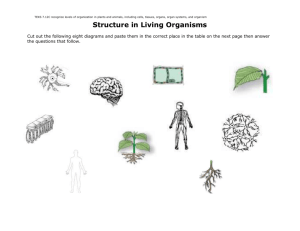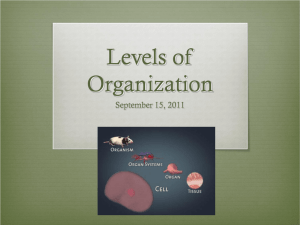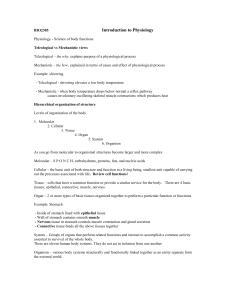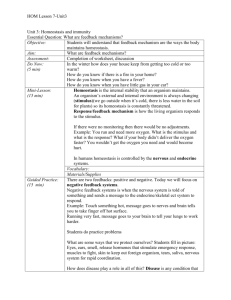8. Organismal Organization / Organs Sytems
advertisement
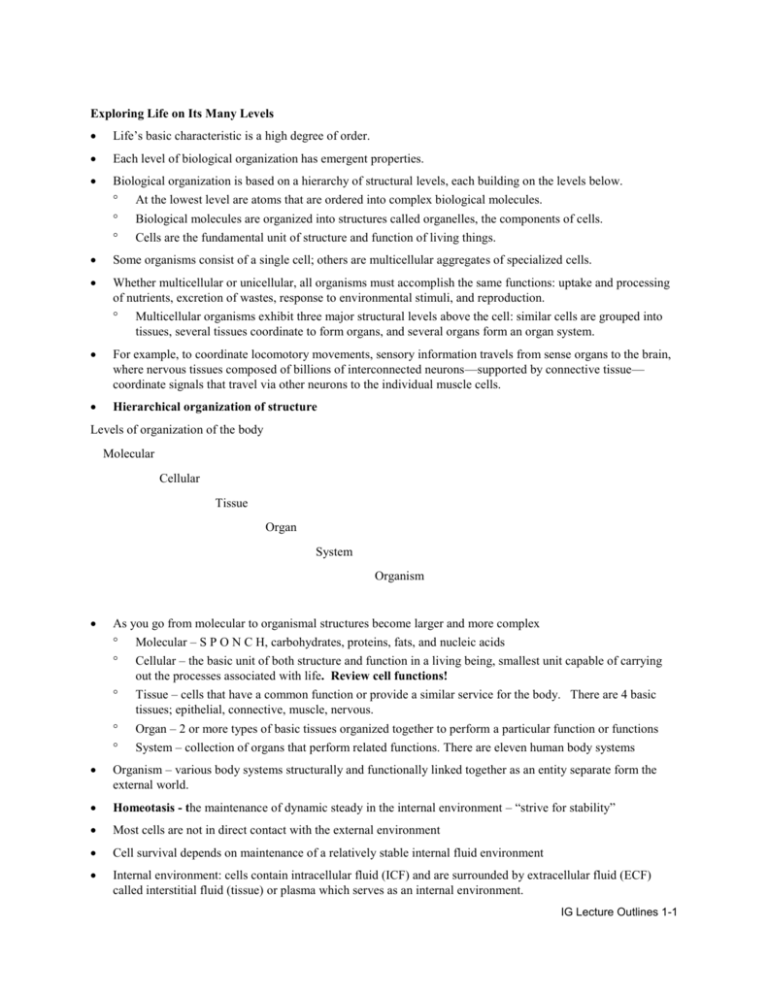
Exploring Life on Its Many Levels Life’s basic characteristic is a high degree of order. Each level of biological organization has emergent properties. Biological organization is based on a hierarchy of structural levels, each building on the levels below. At the lowest level are atoms that are ordered into complex biological molecules. Biological molecules are organized into structures called organelles, the components of cells. Cells are the fundamental unit of structure and function of living things. Some organisms consist of a single cell; others are multicellular aggregates of specialized cells. Whether multicellular or unicellular, all organisms must accomplish the same functions: uptake and processing of nutrients, excretion of wastes, response to environmental stimuli, and reproduction. Multicellular organisms exhibit three major structural levels above the cell: similar cells are grouped into tissues, several tissues coordinate to form organs, and several organs form an organ system. For example, to coordinate locomotory movements, sensory information travels from sense organs to the brain, where nervous tissues composed of billions of interconnected neurons—supported by connective tissue— coordinate signals that travel via other neurons to the individual muscle cells. Hierarchical organization of structure Levels of organization of the body Molecular Cellular Tissue Organ System Organism As you go from molecular to organismal structures become larger and more complex Molecular – S P O N C H, carbohydrates, proteins, fats, and nucleic acids Cellular – the basic unit of both structure and function in a living being, smallest unit capable of carrying out the processes associated with life. Review cell functions! Tissue – cells that have a common function or provide a similar service for the body. There are 4 basic tissues; epithelial, connective, muscle, nervous. Organ – 2 or more types of basic tissues organized together to perform a particular function or functions System – collection of organs that perform related functions. There are eleven human body systems Organism – various body systems structurally and functionally linked together as an entity separate form the external world. Homeotasis - the maintenance of dynamic steady in the internal environment – “strive for stability” Most cells are not in direct contact with the external environment Cell survival depends on maintenance of a relatively stable internal fluid environment Internal environment: cells contain intracellular fluid (ICF) and are surrounded by extracellular fluid (ECF) called interstitial fluid (tissue) or plasma which serves as an internal environment. IG Lecture Outlines 1-1 Factors: [C] of nutrients, O2 [C] of CO2, wastes, byproducts pH [C] of water, electrolytes Temperature Volume/Pressure Homeostasis is essential for each cell’s survival and each cell contributes to a body system function striving to maintain homeostasis Homeostatic control systems Network of body components working together to maintain a given factor in the internal environment directed at an optimal set level Intrinsic control -involves detecting deviations and making corrections within an organ, often called autoregulation, benefits the organ, not the organism Extrinsic control – responses of an organ that are triggered by factors external to the organ or systems. Can over-ride intrinsic regulation, benefits the organism, not necessarily individual organs The major extrinsic control systems are the nervous and endocrine systems To regulate homeostasis the body uses an electrical system (nervous) and a chemical system (endocrine hormones). The nervous system (milliseconds) is generally faster than the endocrine system (seconds to hours). Both systems primarily act automatically, but there is some voluntary control over the nervous system Feedback mechanisms- feedback mechanisms are the general mechanism of nervous or hormonal regulation. Occurs when the response to a stimulus has an effect of some kind on the original stimulus. Negative feedback - response opposite of original deviation returns variable to set point. It provides stable, long-term control. It is most common biological systems. Intrinsic and extrinsic control systems generally operate on the principle of negative feedback Examples: 1. Blood glucose concentrations rise after a sugary meal (the stimulus), the hormone insulin is released and it speeds up the transport of glucose out of the blood and into selected tissues (the response), so blood glucose concentrations decrease (thus decreasing the original stimulus). 2. Exercise creates metabolic heat which raises the body temperature (the stimulus), cooling mechanisms such as vasodilation (flushed skin) and sweating begin (the response), body temperature falls (thus decreasing the original stimulus). Positive feedback - reinforces original deviation causes rapid and temporary change in a variable. It is less common as most changes to steady state pose a threat, and to enhance them would be deleterious. Feedback Loops Regardless of whether the feedback is positive or negative, feedback mechanisms have certain essential components. You should be able to identify each of these and explain their role. Stimulus: A change from optimum or resting conditions Sensor / Receptor: Cells or tissue which detects the deviation due to the stimulus Relay: Transmission of the message, via nerves or hormones or both Integrator / Control center - compares input from sensors with set point and coordinates the effectors Effector: Cells, tissue or organ (usually a gland or muscles), which cause the response to happen. Response: Corrective action, at cell, tissue or whole organism level that drives the variable in the opposite direction of the initial change (back to optimum set point) IG Lecture Outlines 1-2 Feedback: The consequence of the response on the stimulus. May be positive or negative used by the system to determine further action. If the set point has not been reached, effectors continue to produce output, If the set point has been reached, then the effectors stop producing output In addition to feedback mechanisms, the body less frequently employs feedfoward mechanisms which bring about a response in anticipation of a change in a regulated variable Pathophysiological states develop when body systems fail to maintain an optimal internal environment. Serious homeostatic disruption leads to death. IG Lecture Outlines 1-3



